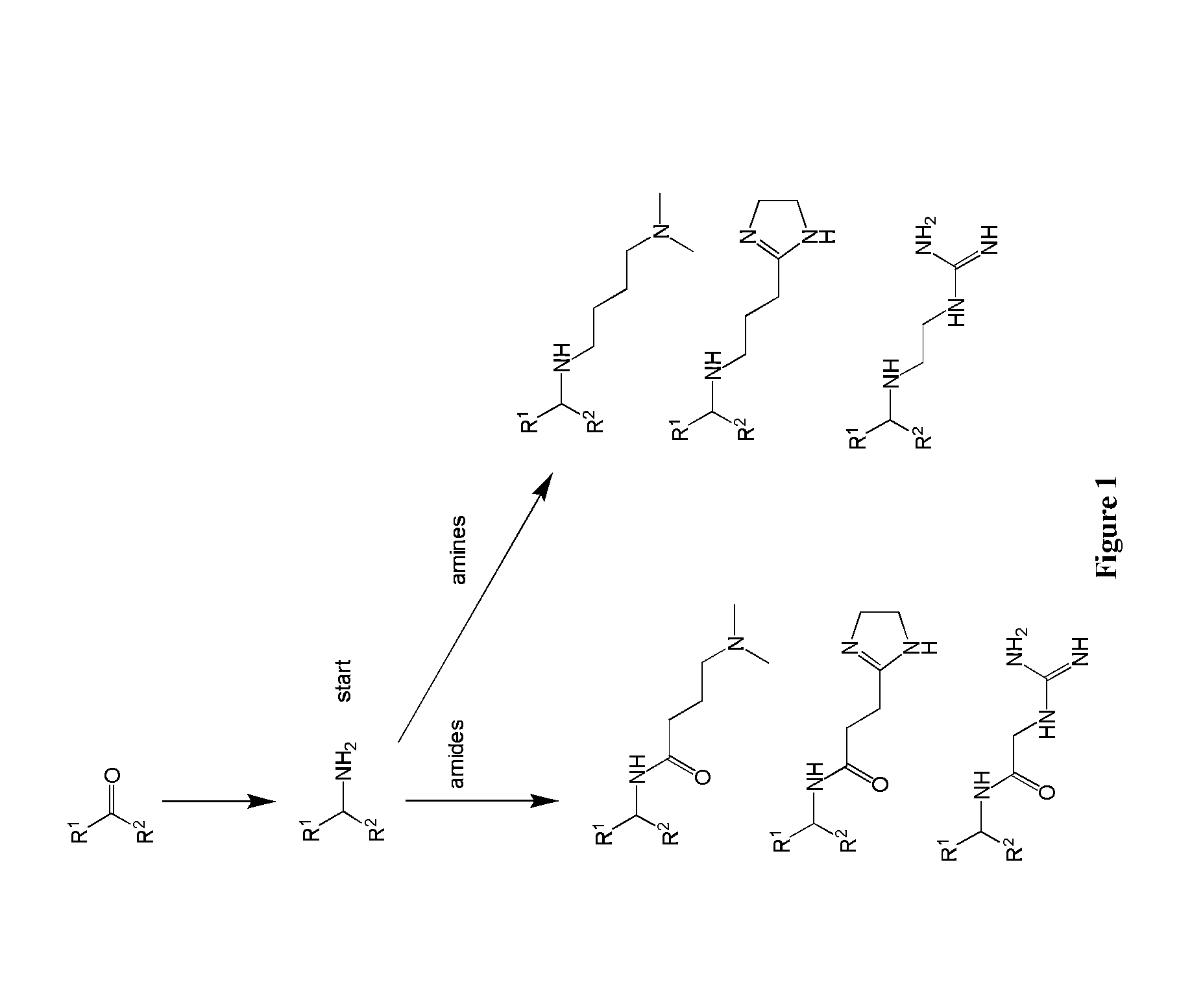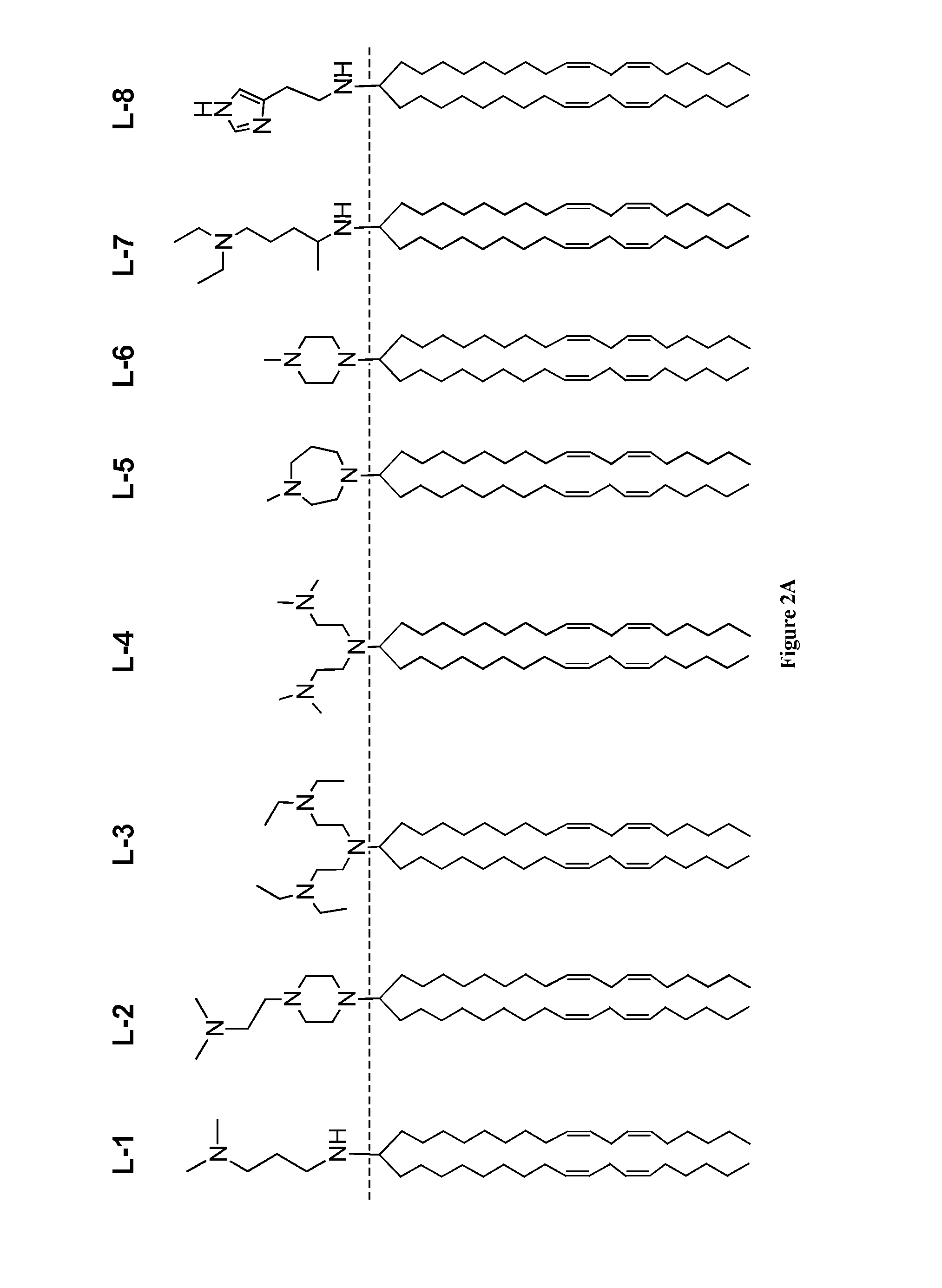Amine Cationic Lipids and Uses Thereof
a technology of cationic lipids and amines, which is applied in the direction of powder delivery, enzymology, drug compositions, etc., can solve the problems of knocking down the target gene, the inability of nucleic acid molecules to easily cross the cell membrane, etc., and achieve the prevention of disease spread, delay or slow the progress of disease, and the extent of disease reduction
- Summary
- Abstract
- Description
- Claims
- Application Information
AI Technical Summary
Benefits of technology
Problems solved by technology
Method used
Image
Examples
example 1
Synthesis of Amino-Amine Lipid L-1 from a Ketone and a Primary Amine
[0273]
[0274]The ketone a (1 eq.) and amine b (1.1 eq.) were dissolved in dichloroethane in a dry flask all under a N2 atmosphere and stirred at room temperature (RT) for 30 minutes. Triacetoxyborohydride (1.5 eq.) was added, and the mixture was stirred overnight at RT. The reaction was quenched with 1 N NaOH. The quenched reaction was diluted with DCM and extracted, once with water, once with brine, and the organic phase was dried over Na2SO4. The dried solution was filtered and concentrated on a rotoevaporator. The residue was purified by silica column (step gradient starting with 1% MeOH / DCM to 5% MeOH / DCM, yields varied from 60% to 90%) to produce compound L-1. H1 NMR (CDCl3): δ 5.41-5.30 (m, 8H), 3.12 (t, 2H), 2.91 (m, 1H), 2.77 (t, 6H), 2.48 (bs, 6H), 2.20 (m, 2H), 2.05 (q, 8H), 1.80-1.69 (m, 4H), 1.38-1.25 (m, 40H), 0.89 (t, 3H); MS: electrospray: [M+1] theory: 613, found: 613.
[0275]By modifying the synthetic ...
example 2
Synthesis of Amino-Amine Lipid L-2 from a Ketone and a Secondary Amine
[0276]
[0277]The ketone a (1 eq.) was dissolved in dry MeOH in a dry flask all under an N2 atmosphere. The amine b (1.1 eq.) was added, followed by triacetoxyborohydride (1.5 eq.) and AcOH (1 eq.), and the reaction was stirred overnight at RT. The reaction was diluted with DCM and extracted, once with water, once with brine, and the organic phase was dried over Na2SO4. The dried solution was filtered and concentrated on a rotoevaporator. The residue was purified by silica column (step gradient starting with 1% MeOH / DCM to 5% MeOH / DCM, yields vary from 60% to 90%) to produce compound L-2. H1 NMR: (CD3OD) δ 5.39-5.30 (m, 8H), 2.78 (t, 4H), 2.59-2.52 (m, 10H), 2.33 (bs, 8H), 2.07 (q, 8H), 1.25 (m, 2H), 1.40-1.26 (m, 40H), 0.914 (t, 6H); MS: electrospray pos. [M+1] theory 668, found 668.
[0278]By modifying the synthetic steps of this example, additional amino-amine lipids were prepared, such as the L-2 and L-6 analogs p...
example 3
Synthesis of the Lipid L-46 from a Ketone and Morpholine
[0279]
[0280]To a mixture of ketone a (2.66 g; 5.05 mmol), morpholine b (1.34 ml; 15 mmol) and AcOH (1.77 ml; 30 mmol) in DCE (12 ml) was added NaBH(AcO)3 (1.6 g; 7.5 mmol). The reaction mixture was stirred at RT for 72 h. TLC test (silica gel; elution with hexane:EtAc-Et3N 95:5) indicated approximately 45% conversion. The reaction mixture was diluted with 5% aqueous K2CO3 and extracted with DCM. The solvent was dried over K2CO3 and evaporated on a rotoevaporator. The residue was separated by LC on silica gel (elution with hexane:EtAc 90:10). The desired product L-46 was obtained in 39% yield (1.18 g) and was pure by NMR.
PUM
| Property | Measurement | Unit |
|---|---|---|
| Fraction | aaaaa | aaaaa |
| Fraction | aaaaa | aaaaa |
| Electrical conductance | aaaaa | aaaaa |
Abstract
Description
Claims
Application Information
 Login to View More
Login to View More - R&D
- Intellectual Property
- Life Sciences
- Materials
- Tech Scout
- Unparalleled Data Quality
- Higher Quality Content
- 60% Fewer Hallucinations
Browse by: Latest US Patents, China's latest patents, Technical Efficacy Thesaurus, Application Domain, Technology Topic, Popular Technical Reports.
© 2025 PatSnap. All rights reserved.Legal|Privacy policy|Modern Slavery Act Transparency Statement|Sitemap|About US| Contact US: help@patsnap.com



